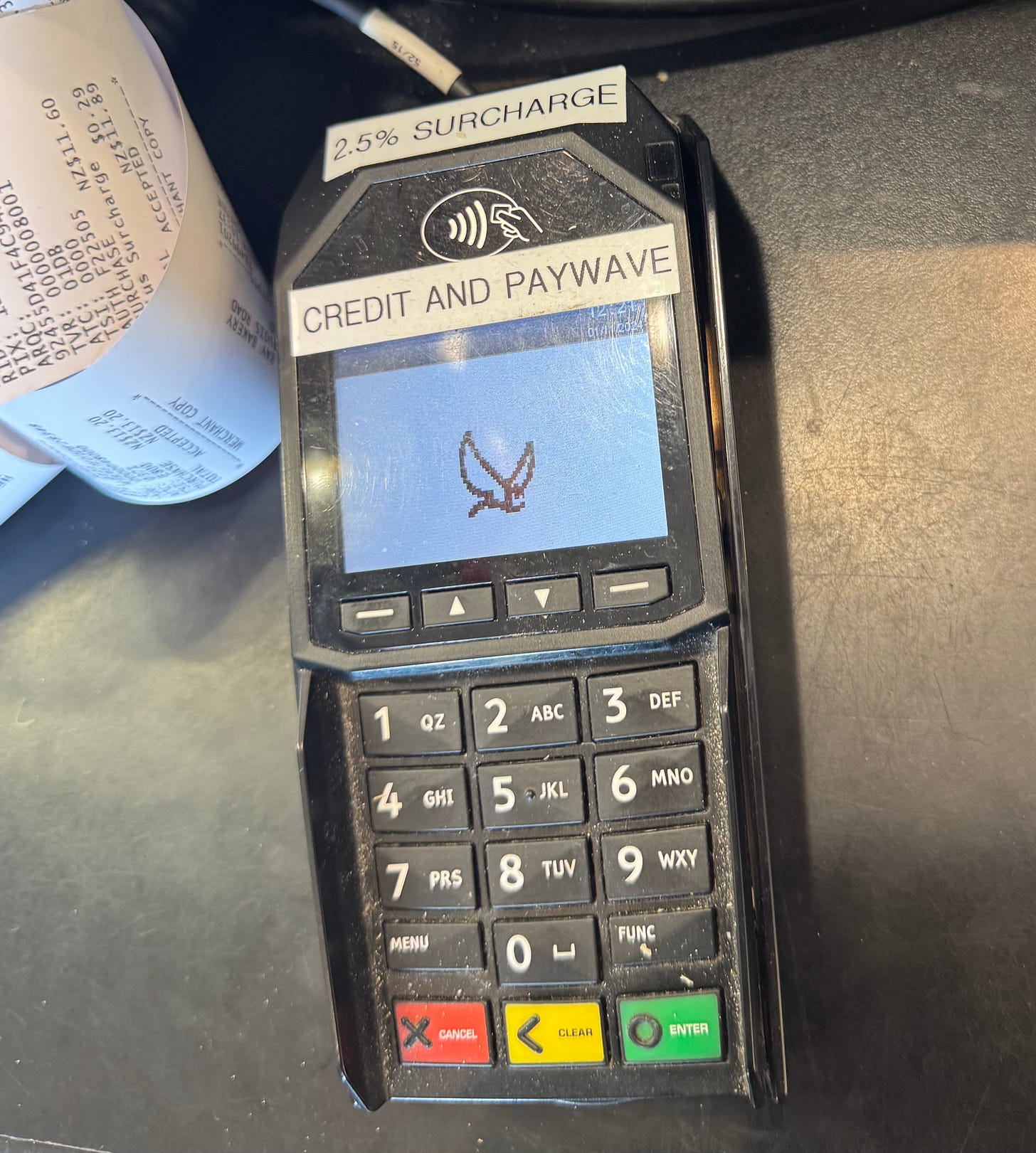Kiwi PayWave Pocket Pains
Contactless payments are convenient, but all those little costs add up
The other day, I met up for breakfast with some business friends. They had cash, and I didn’t, so rather than splitting the bill, they handed me some notes, and I offered to put the $400 breakfast on my card.
PayWave is so convenient, and was adopted so rapidly, that I’d gotten into the habit of using it for everything. Naturally, I was about to tap my card on the machine and be on my way.
The staff were a little busy, so as I stood there staring at the terminal, I had time to actually ruminate on the small sign: “2.5% surcharge for credit and PayWave.”
Doing a quick mental calculation, I realised 2.5% of $400 is $10 — quite a bit more than I’d subconsciously assumed I was paying for “boring old” transaction processing. I’d never really given it much thought before.
In that moment, I decided the five seconds it would take to put away my credit card and pull out my debit card was absolutely worth saving $10. So I swiped instead of tapping.
Later at lunch, I grabbed a Big Mac combo at McDonald's and couldn’t help but feel smug. It was as if that combo was free, paid for entirely by my breakfast switch to EFTPOS.
The Boiled Frog
Remember when PayWave first arrived in New Zealand? It often came with a flat fee — 40 cents was typical, and things like parking meters sometimes charged 50 cents.
For the convenience of fast, contactless payments, most of us accepted those fees. Adoption was rapid. Features like Apple Watch integration made it even more popular.
Up until a few years ago, the price was the price. Whether you paid by cash, EFTPOS, or credit, it was the same amount. Merchants used to absorb the 2.5% credit card fee to encourage purchases.
But somewhere along the way — whether driven by Visa, Mastercard, or simply business owners seeing an opportunity — that simple 40c fee evolved. Now, it’s a 2.5% surcharge on both PayWave AND credit card transactions.
That means my $400 breakfast carried a $10 processing fee — not 40 cents. That’s quite a jump.
When I recently travelled to Australia, I noticed things were still like they used to be. No PayWave surcharges, and the same price whether you paid by card or cash. It made me realise: Kiwis often don’t get the same deal from banks as our Aussie neighbours.
The Money Cycle
Every time you spend money, that money becomes someone else’s income. It flows through the economy in a loop.
In a cash economy, if I have $100, and I pay it to my hairdresser, and he pays his lawn guy, and so on — even after 100 transactions, that $100 is still $100. Nothing has been lost, just passed along.
But add a 2.5% fee to every transaction, and after just 20 uses, 50% of that original $100 has been eaten up in fees. That’s like having a financial barnacle on your boat hull — it slows the economy with every pass.
It’s not a big deal while we still have EFTPOS and cash. But what happens if Visa or Mastercard wins the tender for New Zealand’s “Digital Money” initiative? If there’s no alternative, and they raise the fee to 5% — just like GST crept from 10% to 15% — we’re stuck.
While we have the choice, I say we use cash and EFTPOS, or petition our leaders for the fees to be 0% like they are in Australia.
Summary
2.5% PayWave fees add up quickly — a $1,000 transaction means $25 in extra fees.
We used to pay the same price regardless of payment method. Not anymore.
Most businesses now pass credit card and PayWave fees directly onto consumers and charge 2.5% instead of a flat 40c PayWave transaction fee.
My new rule: for any transaction over $100, I use EFTPOS or debit. That simple change saves me a minimum of $2.50 or more every time.
Convenience is great — but sometimes, it’s worth taking a few extra seconds to keep money in your pocket.



That's great topic! I always practice to check terminal before using payWave. Sometimes they just put note with tape beside it which is often get ignored/hidden and I even once gave bad google review for not making it more visible to customers. My think process is we are always spending little time to figure out where would I get better Term Deposit rates or with which financial provider I will save some management fees or where will I get 2% more return etc. but we are not mindful for few moments in front of terminal where it is decreasing that future return right in front of you.
Have you been viewing The Codfather lately? :-) https://www.facebook.com/thecodfatherwakefield/videos/1193096978950745